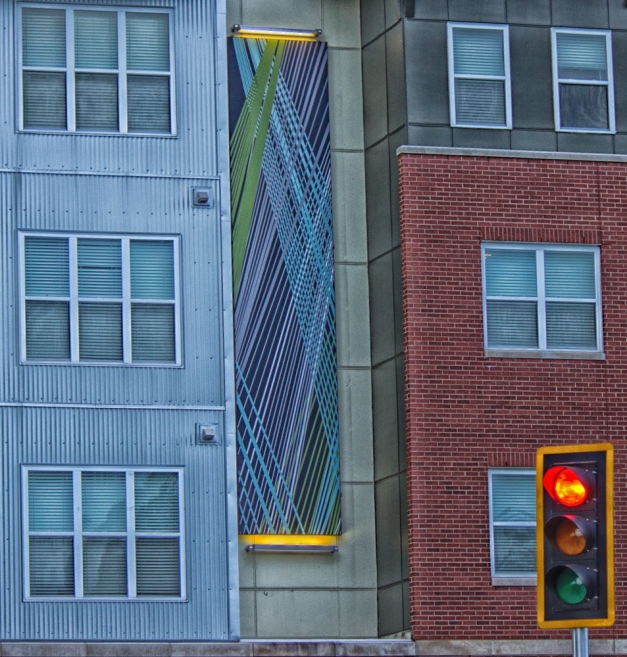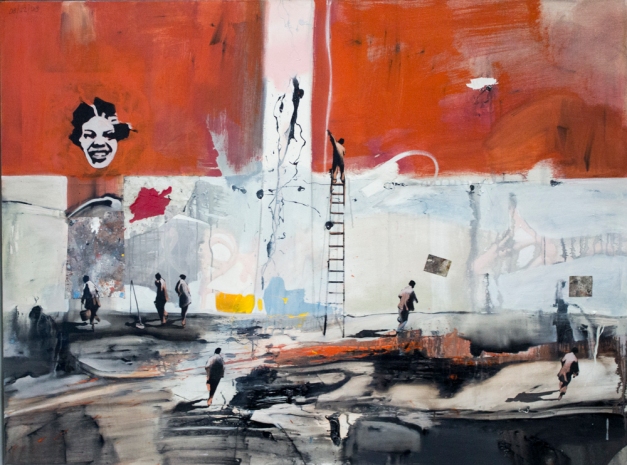
Betty Woodman
color woodcut and monotype collage
42 3/4 x 39 1/2 inches
Collection of the Kemper Museum of Contemporary Art, Kansas City, Missouri
Photography

Untitled, 1985 – 99
Paint on wood
Purvis Young
“Self – taught artist Purvis Young created work that captured life in Overtown in inner-city Miami. An interstate highway built over Overtown in the 1960s drove out many of the once – thriving area’s African American – run businesses and inhabitants. Young opted to stay, painting his vision of his community directly on the walls of abandoned buildings and the alley where he made his home. He also painted on found materials like this tabletop. A red column near its center suggests a figure, while the jumbled high-rises evoke the disorienting nature of urban life.”

Wonder, 1994
Robert Rauschenberg
Collodion transfer and wax on canvas
Marcus Jansen was fourteen years old when he first saw an exhibition catalogue of Robert Rauschenberg’s work. Rauschenberg often incorporated found objects and collage techniques in his compositions, which developed into his signature style. This approach, Jansen has said, inspired him to continue on his path of becoming an artist. Rauschenberg said, “Painting relates to both art and life. Neither can be made. (I try to act in that gap between the two.)” This belief allowed Rauschenberg to create works that move between art and life and are in constant dialogue with the surrounding world. Jansen’s use of found objects and collage techniques to create dialogue about the world is a direct influence of Rauschenberg’s approach to art making.

Untitled (date unknown)
Screen print on paper
Roy Lichtenstein
Roy Lichtenstein’s Untitled (date unknown) appears similiar to works in his Modern series which focused on American architecture and design of the 1920s and 1930s. Using his signature style of comic strip-inspired Pop art, Lichtenstein shows several angles of a commercial building, possibly asking viewers to think about industrial advancements in urban areas.
![]()

The Lichtenstein print reminded me of this photograph I took in Columbus, Indiana.

Mt. Katahdin—November Afternoon (1942)
Marsden Hartley
American, 1877–1943
Oil on Masonite
After years of travel, Marsden Hartley proclaimed himself “the Painter from Maine.” This painting of Mt. Katahdin, Maine’s highest peak, belongs to a series focused on the mountain. Following a visit there in October 1939, Hartley painted multiple canvases over a three-year period. He modified his palette to suggest different seasons in each painting. In Mt. Katahdin—November Afternoon, the contrast between the blue sky, purple mountains, and auburn woods evokes an early-winter day. Hartley identified with the remote peak, seeing it as an emblem of his own lonely resilience.

Fallen Angel (1959)
Oil on canvas
Byron Browne
American (1907-1961)
“A prime example of Abstract Expressionism, Fallen Angel (1959) features a gestural scene of an abstracted angel-like figure. This work showcases his signature style of organic abstract shapes with his studies from nature. Byron Browne was a founding member of the American Abstract Artist, an association to promote and understand Abstract art. Browne and Willem de Kooning (American, 1904-1997), another founder, whose work is also featured in this exhibition, use a range of techniques, from gestural mark making to more detailed brushstrokes and figural abstraction. Jansen echoes both Browne and de Kooning’s painterly gestural strokes in the collaged squares and pavement in Streets, attesting to Jansen’s contemporary conversations with Abstract Expressionism.”

Corner of Studio (1973)
Jane Freilicher
(American)
Oil on canvas
Jane Freilicher began her career as an abstract painter and later turned to representational paintings of still lifes and landscapes. Corner of Studio depicts the Long Island landscape as seen from the windows of her art studio. She uses minimal details o identify the interior space. At the far left, a drawing or unfinished painting is attached to the wall, and a section of a painted landscape leans against the wall’s surface. Both scenes, the landscape in the painting-within-the-painting and the landscape viewed through the set of windows, share the same sense of flatness, or lack of implied distance.

Untitled (Malcolm X) – 2008
Glenn Ligon – American
Acrylic, vinyl based paint, and graphite on paper mounted on fiberboard
Untitled (Malcolm X) is the result of a workshop Glenn Ligon conducted. He presented children with 1970s-era coloring books that had an agenda — to “normalize images of Black Americans to make them part of history. But to a 3-year-old, none of that matters,” he recalls. Eyeshadow, blush, and lipstick on the man once deemed the most dangerous in America by the New York City Police Department may seem transgressive, but the irreverence intrigued Ligon. He silkscreened the image onto canvas, then faithfully painted the Muslim minister, activist, and black nationalist leader just as the child colored him.

Soldier with Death before a Carousel
Arthur Kraft
American (1922-1977)
Graphite and oil on poster board
‘Artist Arthur Kraft’s experience in World War II influenced Soldier with Death before a Carousel (ca. 1947-51). In this painting, a skeleton wearing a helmet and boots holds a champagne flute. This image likely symbolizes the alcohol abuse many veterans face as a result of their traumatic experiences at war. Both Kraft and the artist Marcus Jansen utilize symbolism in their works. Kraft uses the champagne flutes, figures representing death, and white doves; Jansen depicts empty dishes and a few coins in Empty Plates (2007) to emphasize the economic effects of war on communities, families, and individuals. These signs and symbols reveal personal and universal reflections on war across generations.’

